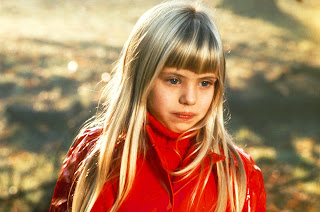John aimlessly clutches Christine in the harrowing opening to the film.
ARGUABLY the most commercial and, in many respects, completely satisfying films by the erratically brilliant Nicolas Roeg, this provocative work has lost little of its power to challenge, shock, and amaze. Roeg is one of Britain’s most adventurous directors, stretching the potential of cinema through a masterly montage of raw emotions, complex time-leaps and splintered narratives, and examining characters forced into a journey of self-exploration when cut adrift from their usual moral and physical milieu. Based on a story by Daphne Du Maurier, DON’T LOOK NOW is a beautifully sensual and restrained horror film, yet it also suggests a world that is perilous, cruel and out of control. Superficially calm, it is an eerie labyrinth that gets under your skin and stays there, underpinned by a constant sense of foreboding that erupts into bloody violence only at the climax; it is a love story with only one love scene, and a study of grief during which nobody cries. This makes the work characteristic of the same peculiar Englishness which informs films as different as BRIEF ENCOUNTER and THE INNOCENTS.
Beginning with every parent’s nightmare – the tragic death of a child – DON’T LOOK NOW examines how grief can overpower emotion, but is cautiously optimistic in its portrayal of how love can transcend death. In the perfectly edited opening sequence, art restorer John Baxter (Donald Sutherland) and his wife Laura (Julie Christie) find their idyllic English country afternoon shattered by the accidental drowning of their young daughter, Christine (Sharon Williams). John experiences an unsettling psychic vision during the tragedy that proves to be a portent of things to come. During lunch at a restaurant in Venice, where John has been brought in to work on a precious holy fresco, the couple are approached by a blind English medium, Heather (Hilary Mason), who informs them that their daughter is expressing happiness and messages of reassurance from the afterlife. During this time the streets of Venice are haunted by a series of gruesome murders - the bodies found drifting in the canals – and John's further visions may be related to a strange figure in a red coat.
Sharon Williams gives a brief yet memorable
performance as doomed Christine Baxter.
performance as doomed Christine Baxter.
The opening drowning takes place with almost unbearable force and awareness, a series of cuts that contain all the keys to the remainder of the film. Roeg's image system is all important, and this sequence introduces the key motifs of the picture; water, both as a source of life and death and as something which needs to be crossed if two people are to be connected; separation, literal or metaphorical, based on geography, belief or simply the way of seeing things; breaking glass, a potent symbol of an accident; scepticism and belief, how one's refusal to believe what's happening can be a fatal mistake; the difference between appearance and reality, as when John says "Nothing is what it seems"; and, perhaps most memorably, the colour red, whether as a harbinger of danger or a way of focusing on something significant.
Until DON’T LOOK NOW, Venice was always used in films to symbolise romance and passion. But here, Roeg unsettles the viewer right from the start, and the whole movie is suffused with shrouded fog and subliminal clues. The transition from Hertfordshire to the cold, autumnal Venice is achieved with a brilliant jump cut from Laura's scream to the whine of a drill, linking the past to the impending horror of the present. Indeed, Venice, similar to the Victorian London in Alan Moore’s From Hell, is turned into a character itself; gloomy, and other. It clouds John's consciousness, rendering him unable to see exactly what is happening as the maze of streets seems to have been designed specifically in order to make the unwary tourist lose their way. The Eternal City seemed to offer comfort and the hope of redemption from the awful feelings of loss but to John Baxter, it provides only terrifying glimpses of a fate which can be delayed but never avoided. Water is everywhere, acting as a reminder of his daughter, and an unavoidable obstacle to getting where he wants to go.
Possessing a star quality and physical presence rare in British cinema, Julie Christie has survived being the representative of a new generation into political activism and grand dame-hood.
DON’T LOOK NOW is a romantic ghost story, but on a deeper level it is also a meditation on perception and fate, where human destiny can be thwarted by a simple misreading of the signs hidden in everyday reality. The film explores what are too fleetingly only referred to as “coincidences,” yet are defining moments of life. The use of colour is especially notable, with all but red being muted and icy blues and greys becoming prominent as John’s search becomes more frustrating. When Baxter pursues the small red-garbed figure at the end of the film, Roeg offers an unforgettable echo back to Prospero’s pursuit of the Red Death in Roger Corman’s THE MASQUE OF THE RED DEATH, a picture in which Roeg acted as cinematographer. Although the film is about death, it is also about love, making it more than just a clever Gothic puzzle. In Christie and Sutherland, we can believe in the ongoing passion of these two adults for each other. The famous love scene, with its non-linear cutting of the couple dressing for dinner, is not played for the usual cinematic effect of seduction or titillation. Rather, it is a natural scene notable for its candour, and for the fact that it seems to communicate love and not just sex. Without this scene, the story would seem less engaging and the interim between the Baxter’s last devoted moments together and their subsequent alienation would be left unexplored.






